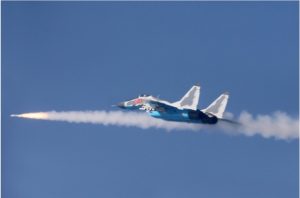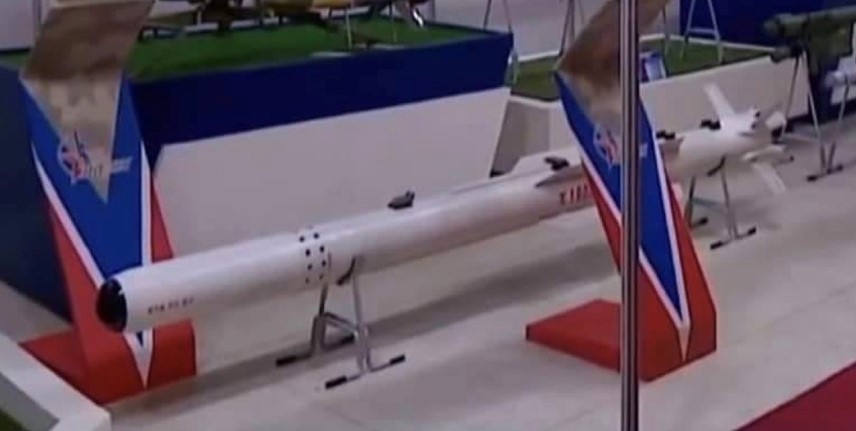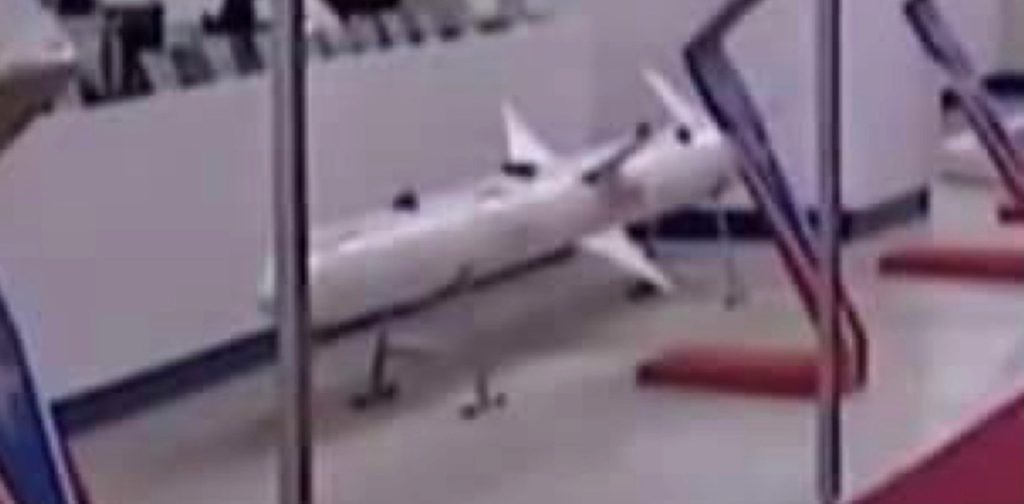Air-to-Air Missiles Could Be the North Korean Defense Sector’s Next Breakthrough: Why It Matters

The ability of North Korean tactical combat aviation to pose a viable challenge to its potential adversaries for even basic air defense duties has fast diminished since the end of the Cold War, a primary cause being political restrictions on the country’s ability to acquire combat aircraft from abroad. As the country’s armed forces invest in improving the avionics of existing fighter aircraft, an important next step would be the integration of modern air-to-air missiles (AAMs)—a feature common to almost all ambitious modernization programs for Cold War-era fighters. The appearance of such missiles at a major arms exhibition in 2021 confirmed longstanding speculation that such programs could be the next step for North Korea’s defense sector, with these assets having the potential to revolutionize the fighter fleet’s capabilities.
Background: North Korea’s Defense Sector After the Cold War
Since the disintegration of the Soviet Union in 1991, and particularly following the imposition and tightening of an arms embargo by the United Nations Security Council (UNSC) in 2006 and 2009, North Korea’s armed forces have been forced to rely almost exclusively on the products of the country’s own defense sector to support their warfighting capabilities. During the 1990s and 2000s, this limited possibilities for modernization considerably, particularly outside the ballistic missile arsenal. However, as the country’s economy began to recover and diversify more rapidly in the 2010s, a wider range of new weapons began to be observed, fulfilling more of the military’s requirements. These ranged from new generations of tanks and anti-tank missiles to infantry fighting vehicles, rocket artillery systems, and even submarines and anti-ship cruise missiles.
A notable gap in North Korea’s ability to modernize its inventories is combat aircraft, with no acquisitions known to have been made since the 1990s, except possibly the early 2000s when unassembled MiG-29 kits and second-hand MiG-21bis fighters were acquired. Like many former Soviet allies, as well as Russia itself, the country has heavily compensated for its post-Cold War disadvantages in the air by deploying a growing range of mobile air defense systems on the ground—including the Pyongae-5 (KN-06), which entered service in 2017 and its unnamed successor, which was unveiled in October 2020. These have provided capabilities that are broadly comparable to the Russian S-300PMU/S-400 systems.
Although the modernization of North Korea’s air defense network, which for decades has been among the world’s densest,[1] is well underway, along with the expansion of its strike capabilities aimed at enemy airfields, the obsolescence of its fighter fleet—even by the standards two decades ago—remains a major outstanding shortcoming.
With the UNSC’s three Western permanent members expected to advocate maintaining at least the earlier rounds of UN sanctions on North Korea indefinitely, acquisitions of new classes of fighter aircraft are not expected to materialize for the foreseeable future. What is possible, however, is that North Korea will seek to leverage its investments in anti-aircraft missile technologies from its new air defense systems to develop air-to-air missiles (AAMs) for its existing aircraft. The country has already invested in integrating modern cockpit displays onto its fighters, and possibly electronic warfare systems, although so far, only their integration onto helicopters has been confirmed. This indicates that enhancements to the North Korean combat fleet have not been neglected when the technologies are available.
Although falling short of modern fighters fielded overseas, enhanced Cold War-era jets with 21st-century avionics and missiles can pose credible threats in air-to-air combat. This was famously demonstrated by the performance of the Indian Air Force’s enhanced MiG-21bis jets in red-on-blue exercises against US Air Force F-15s in the 2000s—and again highlighted when the service credited one of the MiGs with shooting down a Pakistani F-16 in 2019. Should North Korea be able to enhance the weapons and avionics of its MiG-21s, MiG-23s and MiG-29s to a comparable standard, it would represent a major improvement over their baseline capabilities.
The Value of Air-to-Air Missile Development
The first indication that North Korea was developing modern AAMs came in October 2021 at its National Defense Development Exhibition Self-Defense 2021, when a new infrared-guided missile loosely resembling the British AIM-132 and Chinese PL-10 was displayed. Operationalizing a weapon that is comparable to these foreign designs would be a major step toward bringing the North Korean fighter fleet out of obsolescence. It would allow even older fighters, such as MiG-21s, to pose threats at visual ranges and provide them with high off-boresight targeting capabilities (the ability to engage at extreme angles without pointing the aircraft’s nose at its target).
The small size of the battlespace over the Korean Peninsula, and the very large number of fighters that would be involved in a major conflict, means a significant number of engagements would likely occur within visual ranges to avoid friendly fire—ranges where North Korean units’ lack of high off-boresight capabilities is currently an overwhelming disadvantage. Although significant investments in fighter avionics enhancements would be needed to make high off-boresight capable missiles viable, specifically helmet-mounted sights, they would contribute meaningfully to the security of North Korean airspace and the usefulness of its fighter fleet if widely deployed.
Also seen at Self-Defense 2021 was what appeared to be a beyond-visual-range radar-guided AAM. Unlike India’s MiG-21bis squadrons, North Korea’s MiG-21s currently have no beyond visual range missiles whatsoever, while those used by its MiG-23 regiment have very limited ranges and are almost totally obsolete. This leaves only its MiG-29s, which use semi-active radar-guided R-27 missiles, with a somewhat viable ranged anti-aircraft capability. Even a basic first-generation active radar-guided missile, comparable to the American AIM-120A/B, would be significant if it were integrated into MiG-21 and MiG-23 units with accompanying upgrades to avionics, particularly if the aircraft and missiles were able to share targeting data with ground-based air defense platforms. Such a weapon would transform the fighters from near non-players in air defense to much more serious threats when deployed defensively.
Should a range of reports that North Korea has unsuccessfully sought to acquire fighter jets from abroad under multi-billion dollar deals be true, including Russian Su-35s and Chinese J-10s, it would indicate that the North has considerable funds available to invest in modernizing its existing fighter fleet if the technologies become available.
North Korea has repeatedly made headlines since the mid-2010s for the speed at which its missile programs have developed ahead of all expectations. This includes being the world’s third country to develop hypersonic glide vehicle-equipped missiles to being the second with supermaneuverable tactical missiles using irregular semi-ballistic trajectories. These achievements set precedents for North Korea to potentially develop AAMs that, although they are still unlikely to become world leaders in performance, could provide a respectable enough capability to revolutionize the combat potential of the fighter fleet. As further life extension for Soviet-supplied AAMs is expected to become increasingly difficult over the next decade, with missiles approaching 40 years old, the urgency of developing indigenous replacements will only grow.
While the development of miniaturized guidance systems has often been a leading challenge in operationalizing new radar-guided AAMs, the test performances of long-range missiles developed for the Pyongae-5 indicate that key research and development (R&D) obstacles common to guidance systems for both types of anti-aircraft missile have already been overcome. North Korea’s new long-range surface-to-air missiles, although larger than AAMs, still need to be very compact, as do their onboard radars in order to fit into truck-mounted vertical launch cells, with the development of a smaller derivative of their guidance systems suitable for AAMs likely being highly achievable.
While much remains unknown about North Korea’s missile guidance technologies, the capabilities demonstrated by its surface-to-air missiles indicate that the country can likely produce guidance systems for an AAM decades ahead of those of the AAMs it acquired from the Soviet Union in terms of sophistication. This is part of a broader trend of Soviet-supplied defense technologies being surpassed by indigenous ones in a wide range of areas, with the Pyongae-5’s significant advantages over S-200 air defense systems being a particularly relevant example.
The North Korean defense sector’s success in developing advanced surface-to-air missile classes serves as an important indicator of its likely ability to develop relatively capable AAMs. A notable example of this is a sophisticated unnamed missile that is operational with the Pyongae-5’s unnamed successor, which benefits from twin rudder control and a double-impulse flight engine. Using technologies from ground-based systems to develop AAMs, or vice versa, is far from unprecedented—an extreme example being Iran’s development of the oversized Yasser AAM for its F-14 fighters, which is closely based on missiles from the American MIM-23 Hawk air defense system. More conservative examples are China and Germany’s development of their PL-12 and Iris-T AAMs into the Tianlong 50 and Iris-T SLM air defense systems, respectively. These were relatively simple adaptations that the North Korean AAM program could similarly undergo later on to supplement the country’s existing surface-to-air missile systems.
Rather than developing AAMs as a direct adaptation of an existing ground-launched missile, it is much more likely that many of the key technologies for engines, radar guidance, fuel composites, materials and other key areas already developed for air defense systems will be applicable to an AAM program.
Although the future of North Korean combat aviation has been highly uncertain since the 1990s, the domestic development of new AAMs and avionics appears to be the only means of preventing its fighter fleet from becoming totally obsolete in the realm of air defense.
Figure 1. Unknown North Korean High Off-boresight Infrared-homing AAM at Self-Defense 2021.

Figure 2. Unknown North Korean AAM at Self-Defense 2021.

- [1]
The density of an air defense network refers to the quantity of operational air defense assets within an area, with dense networks usually having several varying and complementary systems and high overlaps in coverage between longer-ranged ones.
